达拉草201771010105《面向对象程序设计(java)》第十一周学习总结
达拉草201771010105《面向对象程序设计(java)》第十一周学习总结
实验十一 集合
实验时间 2018-11-8
第一部分:理论知识
1.集合(Collection或称为容器)是一种包含多个元素 并提供对所包含元素操作方法的类,其包含的元 素可以由同一类型的对象组成,也可以由不同类 型的对象组成。
2.集合框架:JAVA集合类库的统一架构。
集合类的作用: –Java的集合类提供了一些基本数据结构的支持。 例如Vector、Hashtable、Stack等。
集合类的使用: –Java的集合类包含在java.util包中。
集合类的特点:
特点一: 只容纳对象。 注意:数组可以容纳基本数据类型数据和对象。 –如果集合类中想使用基本数据类型,又想利用 集合类的灵活性,可以把基本数据类型数据封 装成该数据类型的包装器对象,然后放入集合 中处理。
特点二: 集合类容纳的对象都是Object类的实例,一旦 把一个对象置入集合类中,它的类信息将丢失 ,这样设计的目的是为了集合类的通用性。 因为Object类是所有类的祖先,所以可以在这 些集合中存放任何类的对象而不受限制,但切 记在使用集合成员之前必须对它重新造型。
Vector类:
Vector类类似长度可变的数组。
Vector中只能存放对象。
Vector的元素通过下标进行访问。
Vector类关键属性: capacity表示集合多能容纳的元素个数。 capacityIncrement表示每次增加多少容量。 size表示集合当前元素个数。
Stack类:Stack类是Vector的子类。
Hashtable类:
Hashtable通过键来查找元素。
Hashtable用散列码(hashcode)来确定键。所 有对象都有一个散列码,可以通过Object类的 hashCode()方法获得。
Math.random()方法的随机性。在理想 情况下,该方法应该产生一系列完美的随机分布的 数字。为了验证这一点,需要生成数量众多的随机 数字,然后计算落在不同范围内的数字量。该程序 生成10000个随机数,查看它们在0~20之间的分 布如何。 Math.random()
返回带正号的double值,大于或等于0.0,小于1.0。
集合框架中的基本接口
Collection:集合层次中的根接口,JDK未提供这个 接口的直接实现类。
Set:不能包含重复的元素。对象可能不是按存放的 次序存放,也就是说不能像数组一样按索引的方式进 行访问,SortedSet是一个按照升序排列元素的Set。
List:是一个有序的集合,可以包含重复的元素。提 供了按索引访问的方式。 Map:包含了key-value对。Map不能包含重复的key 。
SortedMap是一个按照升序排列key的Map。
List:
List的明显特征是它的元素 都有一个确定的顺序。
实现它的类有ArrayList和 LinkedList。 –ArrayList中的元素在内存中 是顺序存储的。
LinkedList中的元素在内存 中是以链表方式存储的。 List的明显特征是它的元素 都有一个确定的顺序。
实现它的类有ArrayList和 LinkedList。
ArrayList中的元素在内存中 是顺序存储的。
LinkedList中的元素在内存 中是以链表方式存储的。
Map接:
Map接口的实现类主要有HashMap, TreeMap,Hashtable,Properties。
Hashtable,Properties是JDK1.0/1.1中的。 HashMap对key进行散列。
TreeMap按照key进行排序。
和Set类似,HashMap的速度通常都比 TreeMap快,只有在需要排序的功能的时候 ,才使用TreeMap。
第二部分:实验部分
1、实验目的与要求
(1) 掌握Vetor、Stack、Hashtable三个类的用途及常用API;
(2) 了解java集合框架体系组成;
(3) 掌握ArrayList、LinkList两个类的用途及常用API。
(4) 了解HashSet类、TreeSet类的用途及常用API。
(5)了解HashMap、TreeMap两个类的用途及常用API;
(6) 结对编程(Pair programming)练习,体验程序开发中的两人合作。
2、实验内容和步骤
实验1: 导入第9章示例程序,测试程序并进行代码注释。
测试程序1:
l 使用JDK命令运行编辑、运行以下三个示例程序,结合运行结果理解程序;
l 掌握Vetor、Stack、Hashtable三个类的用途及常用API。
|
//示例程序1 import java.util.Vector; class Cat { private int catNumber; Cat(int i) { catNumber = i; } void print() { System.out.println("Cat #" + catNumber); } } class Dog { private int dogNumber; Dog(int i) { dogNumber = i; } void print() { System.out.println("Dog #" + dogNumber); } } public class CatsAndDogs { public static void main(String[] args) { Vector cats = new Vector(); for (int i = 0; i < 7; i++) cats.addElement(new Cat(i)); cats.addElement(new Dog(7)); for (int i = 0; i < cats.size(); i++) ((Cat) cats.elementAt(i)).print(); } } |
|
//示例程序2 import java.util.*; public class Stacks { static String[] months = { "1", "2", "3", "4" }; public static void main(String[] args) { Stack stk = new Stack(); for (int i = 0; i < months.length; i++) stk.push(months[i]); System.out.println(stk); System.out.println("element 2=" + stk.elementAt(2)); while (!stk.empty()) System.out.println(stk.pop()); } } |
|
//示例程序3 import java.util.*; class Counter { int i = 1; public String toString() { return Integer.toString(i); } } public class Statistics { public static void main(String[] args) { Hashtable ht = new Hashtable(); for (int i = 0; i < 10000; i++) { Integer r = new Integer((int) (Math.random() * 20)); if (ht.containsKey(r)) ((Counter) ht.get(r)).i++; else ht.put(r, new Counter()); } System.out.println(ht); } } |
示例程序一:
import java.util.Vector;
class Cat {
private int catNumber;
Cat(int i) {
catNumber = i;
}
void print() {
System.out.println("Cat #" + catNumber);
}
}
class Dog {
private int dogNumber;
Dog(int i) {
dogNumber = i;
}
void print() {
System.out.println("Dog #" + dogNumber);
}
}
public class CatsAndDogs {
public static void main(String[] args) {
Vector cats = new Vector();
for (int i = 0; i < 7; i++)
cats.addElement(new Cat(i));
cats.addElement(new Dog(7));
for (int i = 0; i < cats.size(); i++)
((Cat) cats.elementAt(i)).print();//进行强制类型转换
}
}
程序运行结果如下
出现这个是由于dog类无法强制类型转换为cat类
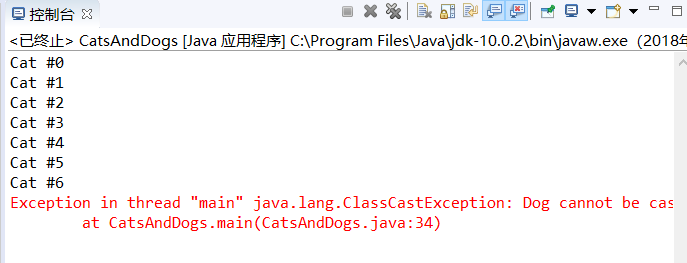
修改之后的程序如下:
import java.util.Vector;
class Cat {
private int catNumber;
Cat(int i) {
catNumber = i;
}
void print() {
System.out.println("Cat #" + catNumber);
}
}
class Dog {
private int dogNumber;
Dog(int i) {
dogNumber = i;
}
void print() {
System.out.println("Dog #" + dogNumber);
}
}
public class CatsAndDogs {
public static void main(String[] args) {
Vector cats = new Vector();
for (int i = 0; i < 7; i++)
cats.addElement(new Cat(i));
cats.addElement(new Dog(7));
for (int i = 0; i < cats.size(); i++) {
if(cats.elementAt(i)instanceof Cat)//instanceof指出对象是否是cat类
{
((Cat) cats.elementAt(i)).print();
}
else
((Dog) cats.elementAt(i)).print();
}
}
}
运行结果如下:

示例程序二:
import java.util.*;
public class Stacks {
static String[] months = { "1", "2", "3", "4" };
public static void main(String[] args) {
Stack stk = new Stack();
for (int i = 0; i < months.length; i++)
stk.push(months[i]);//进栈
System.out.println(stk);
System.out.println("element 2=" + stk.elementAt(2));
while (!stk.empty())
System.out.println(stk.pop());//出栈
}
}
程序运行结果如下:

示例程序三:
import java.util.*;
class Counter {
int i = 1;
public String toString()//把其他类型的数据转化为字符串类型的
{
return Integer.toString(i);
}
}
public class Statistics {
public static void main(String[] args) {
Hashtable ht = new Hashtable();
for (int i = 0; i < 10000; i++) {
Integer r = new Integer((int) (Math.random() * 20));//生成0~1之间的随机数
if (ht.containsKey(r))
((Counter) ht.get(r)).i++;
else
ht.put(r, new Counter());
}
System.out.println(ht);
}
}
运行结果如下:

测试程序2:
l 使用JDK命令编辑运行ArrayListDemo和LinkedListDemo两个程序,结合程序运行结果理解程序;
|
import java.util.*; public class ArrayListDemo { public static void main(String[] argv) { ArrayList al = new ArrayList(); // Add lots of elements to the ArrayList... al.add(new Integer(11)); al.add(new Integer(12)); al.add(new Integer(13)); al.add(new String("hello")); // First print them out using a for loop. System.out.println("Retrieving by index:"); for (int i = 0; i < al.size(); i++) { System.out.println("Element " + i + " = " + al.get(i)); } } } |
|
import java.util.*; public class LinkedListDemo { public static void main(String[] argv) { LinkedList l = new LinkedList(); l.add(new Object()); l.add("Hello"); l.add("zhangsan"); ListIterator li = l.listIterator(0); while (li.hasNext()) System.out.println(li.next()); if (l.indexOf("Hello") < 0) System.err.println("Lookup does not work"); else System.err.println("Lookup works"); } } |
l 在Elipse环境下编辑运行调试教材360页程序9-1,结合程序运行结果理解程序;
l 掌握ArrayList、LinkList两个类的用途及常用API。
1.运行ArrayListDemo:
import java.util.*;
public class ArrayListDemo {
public static void main(String[] argv) {
ArrayList al = new ArrayList();//a1调用ArrayList类数组
//向ArrayList中添加大量元素
al.add(new Integer(11));
al.add(new Integer(12));
al.add(new Integer(13));
al.add(new String("hello"));
// 首先用一个for循环打印出来。
System.out.println("Retrieving by index:");
for (int i = 0; i < al.size(); i++) {
System.out.println("Element " + i + " = " + al.get(i));
}
}
}
运行结果如下:
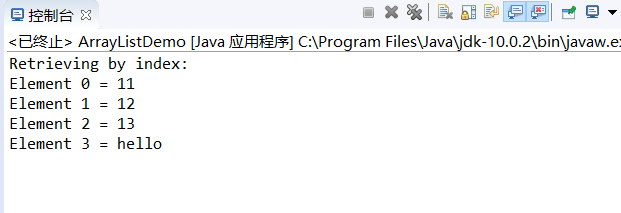
2.运行LinkedListDemo
import java.util.*;
public class LinkedListDemo {
public static void main(String[] argv) {
LinkedList l = new LinkedList();
l.add(new Object());
l.add("Hello");
l.add("zhangsan");
ListIterator li = l.listIterator(0);
while (li.hasNext())
System.out.println(li.next());
if (l.indexOf("Hello") < 0)
System.err.println("Lookup does not work");
else
System.err.println("Lookup works");
}
}
运行结果如下:

3.运行调试教材360页程序9-1
package linkedList; import java.util.*; /**
* This program demonstrates operations on linked lists.
* @version 1.11 2012-01-26
* @author Cay Horstmann
*/
public class LinkedListTest
{
public static void main(String[] args)
{
List<String> a = new LinkedList<>();//创建一个泛型类,用a引用它
a.add("Amy");
a.add("Carl");
a.add("Erica"); List<String> b = new LinkedList<>();
b.add("Bob");
b.add("Doug");
b.add("Frances");
b.add("Gloria"); // 将a和b合并起来 ListIterator<String> aIter = a.listIterator();//遍历a中的所有元素,且a中元素为string类
Iterator<String> bIter = b.iterator(); while (bIter.hasNext())
{
if (aIter.hasNext()) aIter.next();
aIter.add(bIter.next());
} System.out.println(a); // remove every second word from b bIter = b.iterator();
while (bIter.hasNext())
{
bIter.next(); // skip one element
if (bIter.hasNext())
{
bIter.next(); // skip next element
bIter.remove(); // remove that element
}
} System.out.println(b); // bulk operation: remove all words in b from a a.removeAll(b); System.out.println(a);
}
}
运行结果如下;

总结:
1.LinkedList类实现了List接口,允许null元素。此外LinkedList提供额外的get,remove,insert方法在 LinkedList的首部或尾部。
2.ArrayList实现了可变大小的数组。
3.ArrayList方便查询,占用空间小。LinkedList方便添加删除等修改操作,占用空间大。
测试程序3:
l 运行SetDemo程序,结合运行结果理解程序;
|
import java.util.*; public class SetDemo { public static void main(String[] argv) { HashSet h = new HashSet(); //也可以 Set h=new HashSet() h.add("One"); h.add("Two"); h.add("One"); // DUPLICATE h.add("Three"); Iterator it = h.iterator(); while (it.hasNext()) { System.out.println(it.next()); } } } |
l 在Elipse环境下调试教材365页程序9-2,结合运行结果理解程序;了解HashSet类的用途及常用API。
l 在Elipse环境下调试教材367页-368程序9-3、9-4,结合程序运行结果理解程序;了解TreeSet类的用途及常用API。
import java.util.*;
public class SetDemo {
public static void main(String[] argv) {
HashSet h = new HashSet(); //也可以 Set h=new HashSet()
h.add("One");
h.add("Two");
h.add("One"); // DUPLICATE
h.add("Three");
Iterator it = h.iterator();
while (it.hasNext()) {
System.out.println(it.next());
}
}
}
运行结果如下:

在Elipse环境下调试教材365页程序9-2,结合运行结果理解程序;了解HashSet类的用途及常用API。
package set; import java.util.*; /**
* This program uses a set to print all unique words in System.in.
* @version 1.12 2015-06-21
* @author Cay Horstmann
*/
public class SetTest
{
public static void main(String[] args)
{
Set<String> words = new HashSet<>(); // HashSet implements Set
long totalTime = 0; try (Scanner in = new Scanner(System.in))
{
while (in.hasNext())
{
String word = in.next();
long callTime = System.currentTimeMillis();
words.add(word);
callTime = System.currentTimeMillis() - callTime;
totalTime += callTime;
}
} Iterator<String> iter = words.iterator();
for (int i = 1; i <= 20 && iter.hasNext(); i++)
System.out.println(iter.next());
System.out.println(". . .");
System.out.println(words.size() + " distinct words. " + totalTime + " milliseconds.");
}
}
在Elipse环境下调试教材367页-368程序9-3、9-4,结合程序运行结果理解程序;了解TreeSet类的用途及常用API。
package treeSet; import java.util.*; /**
* An item with a description and a part number.
*/
public class Item implements Comparable<Item>
{
private String description;
private int partNumber; /**
* Constructs an item.
*
* @param aDescription
* the item's description
* @param aPartNumber
* the item's part number
*/
public Item(String aDescription, int aPartNumber)
{
description = aDescription;
partNumber = aPartNumber;
} /**
* Gets the description of this item.
*
* @return the description
*/
public String getDescription()
{
return description;
} public String toString()
{
return "[description=" + description + ", partNumber=" + partNumber + "]";
} public boolean equals(Object otherObject)
{
if (this == otherObject) return true;
if (otherObject == null) return false;
if (getClass() != otherObject.getClass()) return false;
Item other = (Item) otherObject;
return Objects.equals(description, other.description) && partNumber == other.partNumber;
} public int hashCode()
{
return Objects.hash(description, partNumber);
} public int compareTo(Item other)
{
int diff = Integer.compare(partNumber, other.partNumber);
return diff != 0 ? diff : description.compareTo(other.description);
}
}
运行结果如下:

测试程序4:
l 使用JDK命令运行HashMapDemo程序,结合程序运行结果理解程序;
|
import java.util.*; public class HashMapDemo { public static void main(String[] argv) { HashMap h = new HashMap(); // The hash maps from company name to address. h.put("Adobe", "Mountain View, CA"); h.put("IBM", "White Plains, NY"); h.put("Sun", "Mountain View, CA"); String queryString = "Adobe"; String resultString = (String)h.get(queryString); System.out.println("They are located in: " + resultString); } } |
l 在Elipse环境下调试教材373页程序9-6,结合程序运行结果理解程序;
l 了解HashMap、TreeMap两个类的用途及常用API。
1.运行HashMapDemo程序,结合程序运行结果理解程序;
package treeSet;
import java.util.*;
public class HashMapDemo {
public static void main(String[] argv) {
HashMap h = new HashMap();
// The hash maps from company name to address.
h.put("Adobe", "Mountain View, CA");
h.put("IBM", "White Plains, NY");
h.put("Sun", "Mountain View, CA");
String queryString = "Adobe";//访问指定的关键字Adobe String resultString = (String)h.get(queryString);
System.out.println("They are located in: " + resultString);
}
}
运行结果如下:

在Elipse环境下调试教材373页程序9-6,结合程序运行结果理解程序;
package map; import java.util.*; /**
* This program demonstrates the use of a map with key type String and value type Employee.
* @version 1.12 2015-06-21
* @author Cay Horstmann
*/
public class MapTest
{
public static void main(String[] args)
{
Map<String, Employee> staff = new HashMap<>();
staff.put("144-25-5464", new Employee("Amy Lee"));
staff.put("567-24-2546", new Employee("Harry Hacker"));
staff.put("157-62-7935", new Employee("Gary Cooper"));
staff.put("456-62-5527", new Employee("Francesca Cruz")); // print all entries System.out.println(staff); // remove an entry staff.remove("567-24-2546"); // replace an entry staff.put("456-62-5527", new Employee("Francesca Miller")); // look up a value System.out.println(staff.get("157-62-7935")); // iterate through all entries staff.forEach((k, v) ->
System.out.println("key=" + k + ", value=" + v));
}
}
运行结果如下:

实验2:结对编程练习:
l 关于结对编程:以下图片是一个结对编程场景:两位学习伙伴坐在一起,面对着同一台显示器,使用着同一键盘,同一个鼠标,他们一起思考问题,一起分析问题,一起编写程序。
l 关于结对编程的阐述可参见以下链接:
http://www.cnblogs.com/xinz/archive/2011/08/07/2130332.html
http://en.wikipedia.org/wiki/Pair_programming
l 对于结对编程中代码设计规范的要求参考:
http://www.cnblogs.com/xinz/archive/2011/11/20/2255971.html
以下实验,就让我们来体验一下结对编程的魅力。
l 确定本次实验结对编程合作伙伴;韩腊梅

l 各自运行合作伙伴实验九编程练习1,结合使用体验对所运行程序提出完善建议;
package gbfdb;
import java.io.BufferedReader;
import java.io.File;
import java.io.FileInputStream;
import java.io.FileNotFoundException;
import java.io.IOException;
import java.io.InputStreamReader;
import java.util.ArrayList;
import java.util.Arrays;
import java.util.Collections;
import java.util.Scanner; public class A{
private static ArrayList<Test> studentlist;
public static void main(String[] args) {
studentlist = new ArrayList<>();
Scanner scanner = new Scanner(System.in);
File file = new File("D:\\身份证号.txt");
try {
FileInputStream fis = new FileInputStream(file);
BufferedReader in = new BufferedReader(new InputStreamReader(fis));
String temp = null;
while ((temp = in.readLine()) != null) { Scanner linescanner = new Scanner(temp); linescanner.useDelimiter(" ");
String name = linescanner.next();
String number = linescanner.next();
String sex = linescanner.next();
String age = linescanner.next();
String province =linescanner.nextLine();
Test student = new Test();
student.setName(name);
student.setnumber(number);
student.setsex(sex);
int a = Integer.parseInt(age);
student.setage(a);
student.setprovince(province);
studentlist.add(student); }
} catch (FileNotFoundException e) {
System.out.println("学生信息文件找不到");
e.printStackTrace();
} catch (IOException e) {
System.out.println("学生信息文件读取错误");
e.printStackTrace();
}
boolean isTrue = true;
while (isTrue) { System.out.println("1:字典排序");
System.out.println("2:输出年龄最大和年龄最小的人");
System.out.println("3:寻找老乡");
System.out.println("4:寻找年龄相近的人");
System.out.println("5:退出");
String m = scanner.next();
switch (m) {
case "1":
Collections.sort(studentlist);
System.out.println(studentlist.toString());
break;
case "2":
int max=0,min=100;
int j,k1 = 0,k2=0;
for(int i=1;i<studentlist.size();i++)
{
j=studentlist.get(i).getage();
if(j>max)
{
max=j;
k1=i;
}
if(j<min)
{
min=j;
k2=i;
} }
System.out.println("年龄最大:"+studentlist.get(k1));
System.out.println("年龄最小:"+studentlist.get(k2));
break;
case "3":
System.out.println("province?");
String find = scanner.next();
String place=find.substring(0,3);
for (int i = 0; i <studentlist.size(); i++)
{
if(studentlist.get(i).getprovince().substring(1,4).equals(place))
System.out.println("province"+studentlist.get(i));
}
break; case "4":
System.out.println("年龄:");
int yourage = scanner.nextInt();
int near=agematched(yourage);
int value=yourage-studentlist.get(near).getage();
System.out.println(""+studentlist.get(near));
break;
case "5":
isTrue = false;
System.out.println("退出程序!");
break;
default:
System.out.println("输入有误"); }
}
}
public static int agematched(int age) {
int j=0,min=53,value=0,k=0;
for (int i = 0; i < studentlist.size(); i++)
{
value=studentlist.get(i).getage()-age;
if(value<0) value=-value;
if (value<min)
{
min=value;
k=i;
}
}
return k;
} }
package gbfdb;
public class Test implements Comparable<Test> { private String name;
private String number ;
private String sex ;
private int age;
private String province; public String getName() {
return name;
}
public void setName(String name) {
this.name = name;
}
public String getnumber() {
return number;
}
public void setnumber(String number) {
this.number = number;
}
public String getsex() {
return sex ;
}
public void setsex(String sex ) {
this.sex =sex ;
}
public int getage() { return age;
}
public void setage(int age) { this.age= age;
} public String getprovince() {
return province;
}
public void setprovince(String province) {
this.province=province ;
} public int compareTo(Test o) {
return this.name.compareTo(o.getName());
} public String toString() {
return name+"\t"+sex+"\t"+age+"\t"+number+"\t"+province+"\n";
} }
运行结果如下:
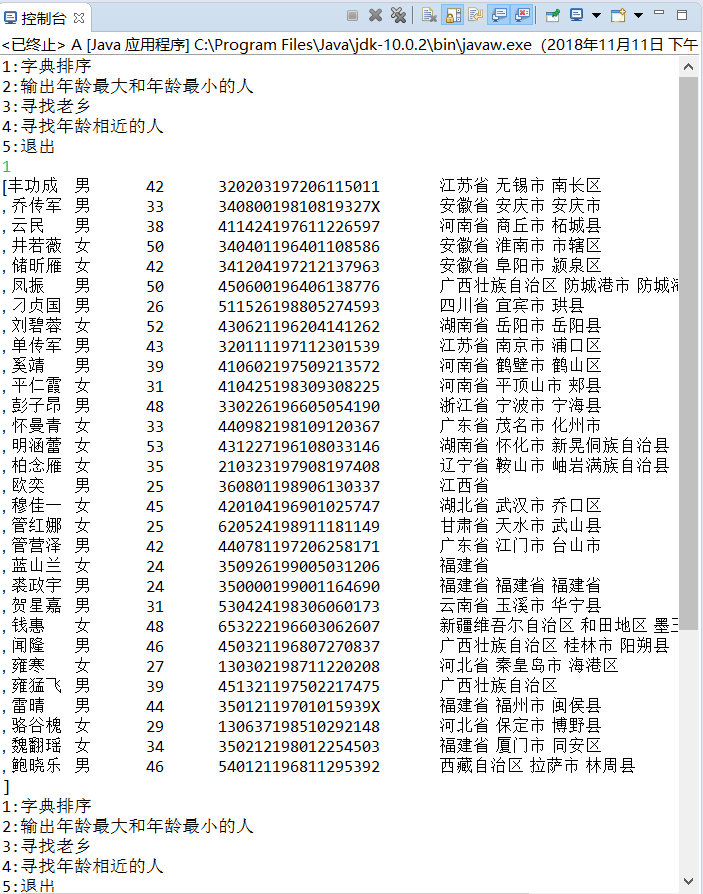
l 各自运行合作伙伴实验十编程练习2,结合使用体验对所运行程序提出完善建议;
package gbfdb;
import java.util.Random;
import java.util.Scanner; import java.io.FileNotFoundException; import java.io.PrintWriter; public class Main{
public static void main(String[] args)
{ yunsuan counter=new yunsuan();//与其它类建立联系
PrintWriter out=null;
try {
out=new PrintWriter("D:/text.txt");//将文件里的内容读入到D盘名叫text的文件中 }catch(FileNotFoundException e) {
System.out.println("文件找不到");
e.printStackTrace();
} int sum=0; for(int i=0;i<10;i++)
{
int a=new Random().nextInt(100);
int b=new Random().nextInt(100);
Scanner in=new Scanner(System.in);
//in.close(); switch((int)(Math.random()*4)) { case 0:
System.out.println( ""+a+"+"+b+"="); int c1 = in.nextInt();
out.println(a+"+"+b+"="+c1);
if (c1 == counter.plus(a, b)) {
sum += 10;
System.out.println("答案正确");
}
else {
System.out.println("答案错误");
} break ;
case 1:
if(a<b)
{
int temp=a;
a=b;
b=temp;
}//为避免减数比被减数大的情况 System.out.println(""+a+"-"+b+"=");
/*while((a-b)<0)
{
b = (int) Math.round(Math.random() * 100); }*/
int c2 = in.nextInt(); out.println(a+"-"+b+"="+c2);
if (c2 == counter.minus(a, b)) {
sum += 10;
System.out.println("答案正确");
}
else {
System.out.println("答案错误");
} break ; case 2: System.out.println(""+a+"*"+b+"=");
int c = in.nextInt();
out.println(a+"*"+b+"="+c);
if (c == counter.multiply(a, b)) {
sum += 10;
System.out.println("答案正确");
}
else {
System.out.println("答案错误");
}
break;
case 3: while(b==0)
{ b = (int) Math.round(Math.random() * 100);//满足分母不为0
}
while(a%b!=0)
{
a = (int) Math.round(Math.random() * 100);
b = (int) Math.round(Math.random() * 100);
}
System.out.println(""+a+"/"+b+"=");
int c0= in.nextInt(); out.println(a+"/"+b+"="+c0);
if (c0 == counter.divide(a, b)) {
sum += 10;
System.out.println("答案正确");
}
else {
System.out.println("答案错误");
} break; }
}
System.out.println("totlescore:"+sum);
out.println(sum); out.close();
}
}
package gbfdb;
public class yunsuan <T>{
private T a;
private T b;
public void yunsaun()
{
a=null;
b=null;
}
public void yunsuan(T a,T b)
{
this.a=a;
this.b=b;
}
public int plus(int a,int b)
{
return a+b; }
public int minus(int a,int b)
{
return a-b; }
public int multiply(int a,int b)
{
return a*b;
}
public int divide(int a,int b)
{
if(b!=0 && a%b==0)
return a/b;
else
return 0;
}
}
运行结果如下:
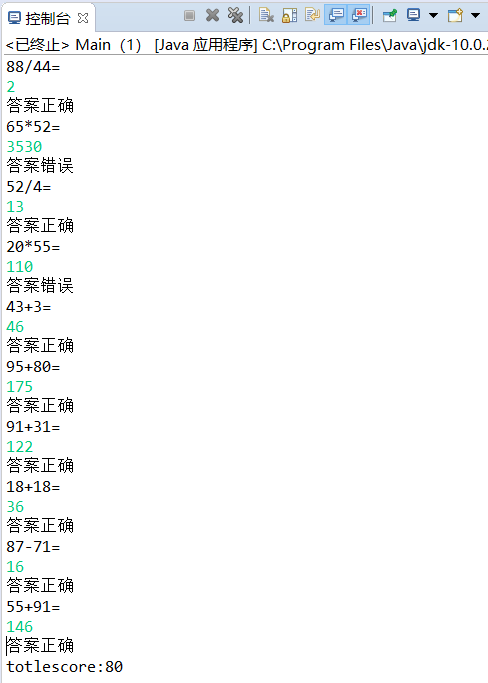
l 采用结对编程方式,与学习伙伴合作完成实验九编程练习1;
package gbfdb;
import java.io.BufferedReader;
import java.io.File;
import java.io.FileInputStream;
import java.io.FileNotFoundException;
import java.io.IOException;
import java.io.InputStreamReader;
import java.util.ArrayList;
import java.util.Arrays;
import java.util.Collections;
import java.util.Scanner; public class Moom{
private static ArrayList<Mest> studentlist;
public static void main(String[] args) {
studentlist = new ArrayList<>();
Scanner scanner = new Scanner(System.in);
File file = new File("D:\\身份证号.txt");
try {
FileInputStream fis = new FileInputStream(file);
BufferedReader in = new BufferedReader(new InputStreamReader(fis));
String temp = null;
while ((temp = in.readLine()) != null) { Scanner linescanner = new Scanner(temp); linescanner.useDelimiter(" ");
String name = linescanner.next();
String number = linescanner.next();
String sex = linescanner.next();
String age = linescanner.next();
String province =linescanner.nextLine();
Mest student = new Mest();
student.setName(name);
student.setnumber(number);
student.setsex(sex);
int a = Integer.parseInt(age);
student.setage(a);
student.setprovince(province);
studentlist.add(student); }
} catch (FileNotFoundException e) {
System.out.println("学生信息文件找不到");
e.printStackTrace();
} catch (IOException e) {
System.out.println("学生信息文件读取错误");
e.printStackTrace();
}
boolean isTrue = true;
while (isTrue) { System.out.println("1:字典排序");
System.out.println("2:输出年龄最大和年龄最小的人");
System.out.println("3:寻找老乡");
System.out.println("4:寻找年龄相近的人");
System.out.println("5:退出");
String m = scanner.next();
switch (m) {
case "1":
Collections.sort(studentlist);
System.out.println(studentlist.toString());
break;
case "2":
int max=0,min=100;
int j,k1 = 0,k2=0;
for(int i=1;i<studentlist.size();i++)
{
j=studentlist.get(i).getage();
if(j>max)
{
max=j;
k1=i;
}
if(j<min)
{
min=j;
k2=i;
} }
System.out.println("年龄最大:"+studentlist.get(k1));
System.out.println("年龄最小:"+studentlist.get(k2));
break;
case "3":
System.out.println("家庭住址:");
String find = scanner.next();
String place=find.substring(0,3);
for (int i = 0; i <studentlist.size(); i++)
{
if(studentlist.get(i).getprovince().substring(1,4).equals(place))
System.out.println("province"+studentlist.get(i));
}
break; case "4":
System.out.println("年龄:");
int yourage = scanner.nextInt();
int near=agematched(yourage);
int value=yourage-studentlist.get(near).getage();
System.out.println(""+studentlist.get(near));
break;
case "5":
isTrue = false;
System.out.println("退出程序!");
break;
default:
System.out.println("输入错误"); }
}
}
public static int agematched(int age) {
int j=0,min=53,value=0,k=0;
for (int i = 0; i < studentlist.size(); i++)
{
value=studentlist.get(i).getage()-age;
if(value<0) value=-value;
if (value<min)
{
min=value;
k=i;
}
}
return k;
} }
package gbfdb;
public class Mest implements Comparable<Mest> { private String name;
private String number ;
private String sex ;
private int age;
private String province; public String getName() {
return name;
}
public void setName(String name) {
this.name = name;
}
public String getnumber() {
return number;
}
public void setnumber(String number) {
this.number = number;
}
public String getsex() {
return sex ;
}
public void setsex(String sex ) {
this.sex =sex ;
}
public int getage() { return age;
}
public void setage(int age) { this.age= age;
} public String getprovince() {
return province;
}
public void setprovince(String province) {
this.province=province ;
} public int compareTo(Mest o) {
return this.name.compareTo(o.getName());
} public String toString() {
return name+"\t"+sex+"\t"+age+"\t"+number+"\t"+province+"\n";
} }
运行结果如下:
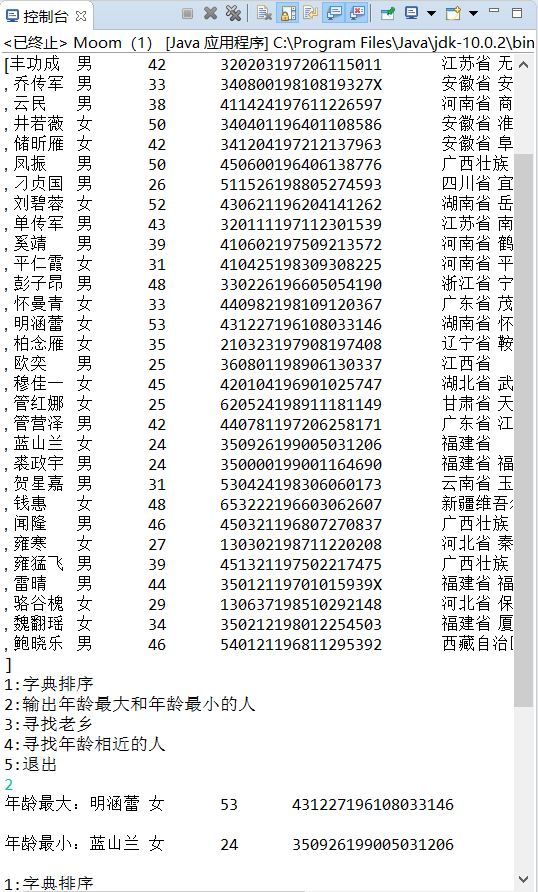
l 采用结对编程方式,与学习伙伴合作完成实验十编程练习2。
package gbfdb;
import java.util.Random;
import java.util.Scanner; import java.io.FileNotFoundException; import java.io.PrintWriter; public class Main{
public static void main(String[] args)
{ yunsuan counter=new yunsuan();//与其它类建立联系
PrintWriter out=null;
try {
out=new PrintWriter("D:/text.txt");//将文件里的内容读入到D盘名叫text的文件中 }catch(FileNotFoundException e) {
System.out.println("文件找不到");
e.printStackTrace();
} int sum=0; for(int i=0;i<10;i++)
{
int a=new Random().nextInt(100);
int b=new Random().nextInt(100);
Scanner in=new Scanner(System.in);
//in.close(); switch((int)(Math.random()*4)) { case 0:
System.out.println( ""+a+"+"+b+"="); int c1 = in.nextInt();
out.println(a+"+"+b+"="+c1);
if (c1 == counter.plus(a, b)) {
sum += 10;
System.out.println("答案正确");
}
else {
System.out.println("答案错误");
} break ;
case 1:
if(a<b)
{
int temp=a;
a=b;
b=temp;
}//为避免减数比被减数大的情况 System.out.println(""+a+"-"+b+"=");
/*while((a-b)<0)
{
b = (int) Math.round(Math.random() * 100); }*/
int c2 = in.nextInt(); out.println(a+"-"+b+"="+c2);
if (c2 == counter.minus(a, b)) {
sum += 10;
System.out.println("答案正确");
}
else {
System.out.println("答案错误");
} break ; case 2: System.out.println(""+a+"*"+b+"=");
int c = in.nextInt();
out.println(a+"*"+b+"="+c);
if (c == counter.multiply(a, b)) {
sum += 10;
System.out.println("答案正确");
}
else {
System.out.println("答案错误");
}
break;
case 3: while(b==0)
{ b = (int) Math.round(Math.random() * 100);//满足分母不为0
}
while(a%b!=0)
{
a = (int) Math.round(Math.random() * 100);
b = (int) Math.round(Math.random() * 100);
}
System.out.println(""+a+"/"+b+"=");
int c0= in.nextInt(); out.println(a+"/"+b+"="+c0);
if (c0 == counter.divide(a, b)) {
sum += 10;
System.out.println("答案正确");
}
else {
System.out.println("答案错误");
} break; }
}
System.out.println("totlescore:"+sum);
out.println(sum); out.close();
}
}
package gbfdb;
public class yunsuan <T>{
private T a;
private T b;
public void yunsaun()
{
a=null;
b=null;
}
public void yunsuan(T a,T b)
{
this.a=a;
this.b=b;
}
public int plus(int a,int b)
{
return a+b; }
public int minus(int a,int b)
{
return a-b; }
public int multiply(int a,int b)
{
return a*b;
}
public int divide(int a,int b)
{
if(b!=0 && a%b==0)
return a/b;
else
return 0;
}
}
运行结果如下:

实验总结:
这周我们通过一种新的学习方式结对编程进行这周的编程实验,我觉得结对编程可以让我们交流我们的思路,然后可以发现我们自己的不足。这周我们学习了集合,掌握了java中集合的概念,学习了集合的知识以及使用方法。
达拉草201771010105《面向对象程序设计(java)》第十一周学习总结的更多相关文章
- 201771010134杨其菊《面向对象程序设计java》第九周学习总结
第九周学习总结 第一部分:理论知识 异常.断言和调试.日志 1.捕获 ...
- 201871010132-张潇潇《面向对象程序设计(java)》第一周学习总结
面向对象程序设计(Java) 博文正文开头 项目 内容 这个作业属于哪个课程 https://www.cnblogs.com/nwnu-daizh/ 这个作业的要求在哪里 https://www.cn ...
- 扎西平措 201571030332《面向对象程序设计 Java 》第一周学习总结
<面向对象程序设计(java)>第一周学习总结 正文开头: 项目 内容 这个作业属于哪个课程 https://www.cnblogs.com/nwnu-daizh/ 这个作业的要求在哪里 ...
- 杨其菊201771010134《面向对象程序设计Java》第二周学习总结
第三章 Java基本程序设计结构 第一部分:(理论知识部分) 本章主要学习:基本内容:数据类型:变量:运算符:类型转换,字符串,输入输出,控制流程,大数值以及数组. 1.基本概念: 1)标识符:由字母 ...
- 201871010124 王生涛《面向对象程序设计JAVA》第一周学习总结
项目 内容 这个作业属于哪个课程 https://www.cnblogs.com/nwnu-daizh/ 这个作业的要求在哪里 https://edu.cnblogs.com/campus/xbsf/ ...
- 201871010115——马北《面向对象程序设计JAVA》第二周学习总结
项目 内容 这个作业属于哪个课程 https://www.cnblogs.com/nwnu-daizh/ 这个作业的要求在哪里 https://www.cnblogs.com/nwnu-daizh/p ...
- 201777010217-金云馨《面向对象程序设计(Java)》第二周学习总结
项目 内容 这个作业属于哪个课程 https://www.cnblogs.com/nwnu-daizh/ 这个作业的要求在哪里 https://www.cnblogs.com/nwnu-daizh/p ...
- 201871010132——张潇潇《面向对象程序设计JAVA》第二周学习总结
项目 内容 这个作业属于哪个课程 https://www.cnblogs.com/nwnu-daizh/ 这个作业的要求在哪里 https://www.cnblogs.com/nwnu-daizh/p ...
- 201771010123汪慧和《面向对象程序设计Java》第二周学习总结
一.理论知识部分 1.标识符由字母.下划线.美元符号和数字组成, 且第一个符号不能为数字.标识符可用作: 类名.变量名.方法名.数组名.文件名等.第二部分:理论知识学习部分 2.关键字就是Java语言 ...
- 达拉草201771010105《面向对象程序设计(java)》第三周学习总结
达拉草201771010105«面向对象程序设计(java)»第三周学习总结 第一部分:实验部分 1.实验目的与要求 (1)进一步掌握Eclipse集成开发环境下java程序开发基本步骤: (2)熟 ...
随机推荐
- Codeforces 1288A - Deadline
题目大意: Adilbek有一个特殊项目,他需要运行这个项目得到结果. 但是这个项目直接运行需要消耗d天时间. 他也可以选择优化程序以减少程序运行消耗时间. 假设他用了x天优化程序,那么最后运行程序只 ...
- Codeforces 1293A - ConneR and the A.R.C. Markland-N
题目大意: ConneR老师想吃东西,他现在在大楼的第s层,大楼总共有n层,但是其中有k层的餐厅关门了. 然后给了这k层关门的餐厅分别所在的楼层. 所以问ConneR老师最少得往上(或者往下)走几层楼 ...
- Opencv笔记(七)——访问与操作像素
一.获取矩阵的元素 1.获取三维矩阵img[i,j]处的元素 (b,g,r) = image[i,j],image大小为:MxNxK. 2.获取三维矩阵的子矩阵的全部元素 newimage = ima ...
- 802.11X
LSW1; interface Vlanif100 ip address 192.168.121.2 255.255.255.0连接云的地址 interface GigabitEthernet0/0/ ...
- 【shell】概述
功能简介 批量自动初始化系统(update,软件安装,时区设置,安全策略...) 批量自动部署软件(LAMP,LNMP,Nginx,LVS,Tomcat) 管理应用程序(KVM,集群管理扩容,MySQ ...
- 二十六、linux邮件服务器
1.安装: yum install -y sendmail 因为是最小安装,需要包没有安装 yum install -y mailx 2.日志:/var/log/maillog 3.启动:/etc ...
- poj 2342树形dp板子题1
http://poj.org/problem?id=2342 #include<iostream> #include<cstdio> #include<cstring&g ...
- LTE-U/LAA
将LTE扩展至非授权频谱,得益于一个稳健的无线电通信线路,具有更好协调性的同步节点,以及以授权频谱为基点的载波聚合,LTE-U/LAA能提供比载波Wi-Fi更佳的网络性能和更强的用户体验,为移动运营商 ...
- python语法基础-函数-迭代器和生成器-长期维护
############### 迭代器 ############## """ 迭代器 这是一个新的知识点 我们学习过的可以迭代的对象有哪些? list str ...
- 创建框架链接--frameset的连接方法
首先看下小编的目录架构 1.html将作为主页面 2.html将作为目录页面,里面有2个目录,分别是目录一和目录二 3.html为目录一将要链接的页面 4.html为目录二将要链接的页面 然后,看下1 ...
